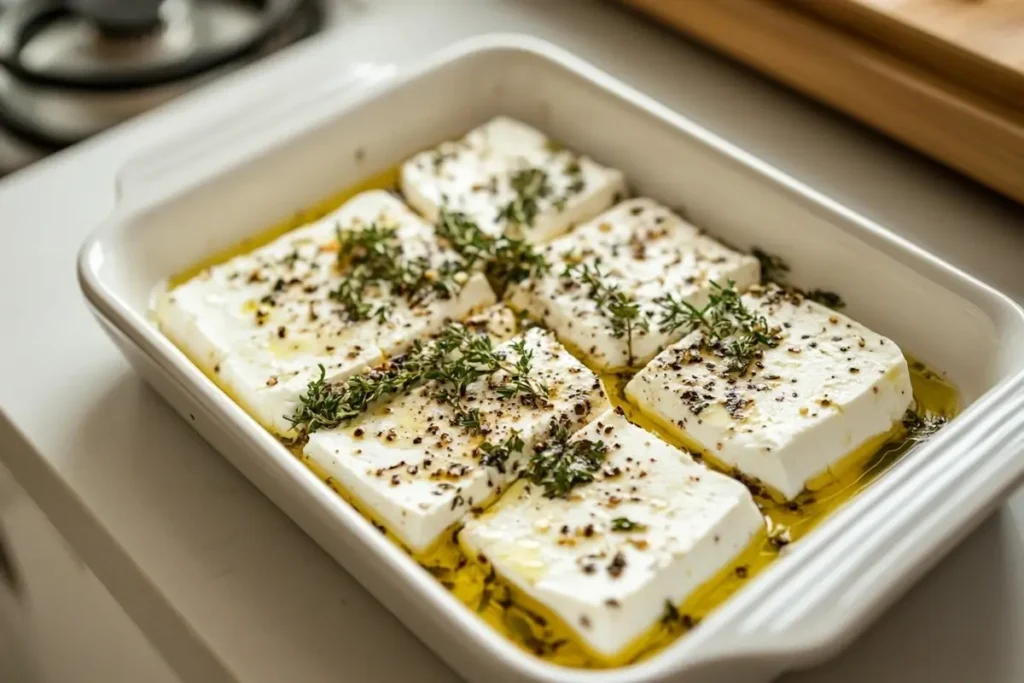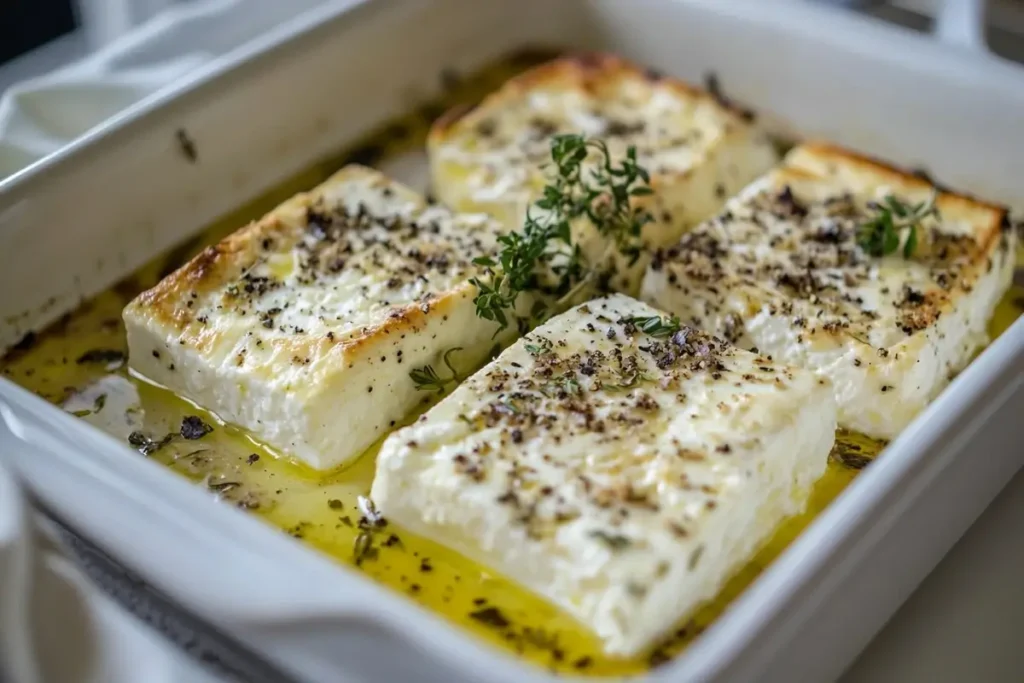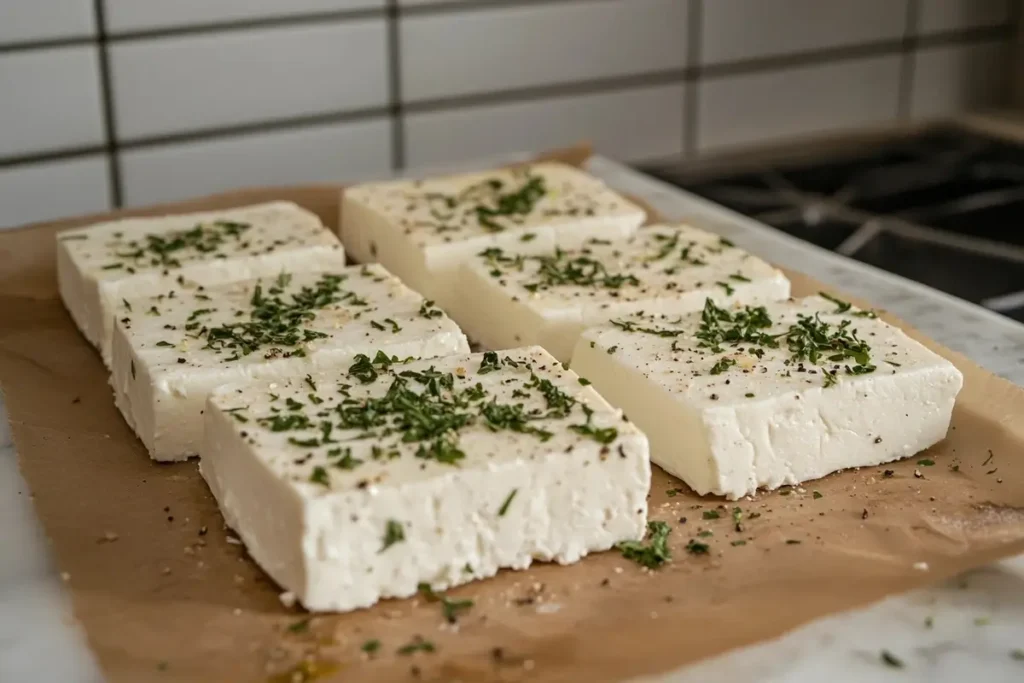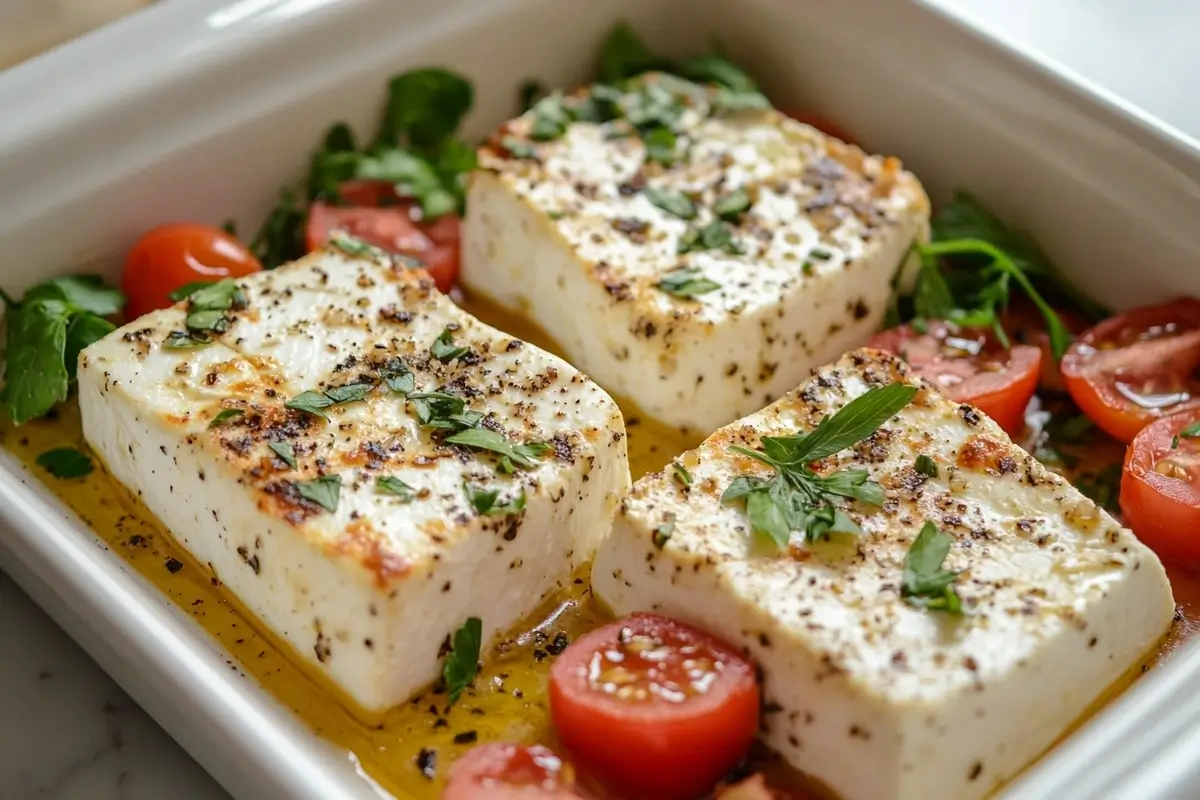Introduction
How long to bake feta in the oven? This is a question many home cooks ask when they want to transform a simple block of cheese into a warm, savory delight. Baking feta unlocks its tangy richness, creating a soft texture that complements countless dishes. In this Ultimate guide, we will explore everything you need to know to master the art of oven-baking feta. From selecting the right type of feta to mastering the ideal time and temperature, get ready to discover the amazing ways you can elevate your meals with baked feta.
Oven-baked feta has gained popularity due to its bold flavor and creamy consistency. Whether you enjoy it as a standalone appetizer or as a vibrant ingredient in pasta, salads, or casseroles, this simple technique has become a go-to solution for anyone looking to add excitement to their meals. Therefore, let’s dive into the ins and outs of how long to bake feta in the oven, so you can create irresistible dishes that will have everyone asking for second helpings.

Why Bake Feta in the Oven?
Baking feta in the oven is more than just a quick culinary trick. It’s a method that enhances flavor, creates new textures, and offers endless possibilities for improvisation. When exposed to heat, feta becomes soft and slightly melted around the edges, adding a creamy mouthfeel to your dish.
Furthermore, oven-baking can mellow the sharper tang of feta. The process allows other flavors to mingle, creating a balanced taste that blends tanginess with savory notes. Therefore, when you’re experimenting with recipes, baked feta can be the star attraction or a complementary sidekick that ties all the ingredients together.
The Allure of Warm, Creamy Feta
If you’re a cheese enthusiast, you know that warm cheese is a crowd-pleaser. Baked feta offers that comforting melt without losing its structure. Unlike cheeses that become overly gooey, feta maintains some firmness, which makes it easy to serve in slices or cubes.
Additionally, oven-baked feta pairs beautifully with roasted vegetables, crusty bread, olives, and fresh herbs. Whether sprinkled on top of a homemade pizza or stirred into a hearty pasta dish, baked feta brings a burst of savory goodness to every bite.

Selecting the Best Feta for Baking
While “feta” is a catch-all term, not all feta is created equal. Traditional Greek feta is typically made from sheep’s milk or a combination of sheep’s and goat’s milk. This version offers a rich, tangy flavor profile ideal for baking. However, there are also cow’s milk versions available in many supermarkets, which often taste milder.
Key Factors to Consider
- Texture: Look for a block labeled as “firm.” You want a feta that holds together in the oven. A crumbly or overly soft feta may melt too quickly or lose its shape.
- Salt Content: Feta can vary widely in saltiness. Extremely salty feta can overpower a recipe. If possible, taste a small piece beforehand to adjust seasonings in your dish.
- Packaging: Fresh feta often comes packed in brine. This indicates higher moisture content, which can keep the cheese from drying out while baking.
Moreover, consider experimenting with artisanal or specialty brands. You may discover subtle flavor differences, from earthy undertones to mild grassy notes. Each nuance can add an extra layer of complexity when you bake feta in the oven.
How Long to Bake Feta in the Oven?
“How long to bake feta in the oven?” is the million-dollar question that we’re here to answer. The short answer: Typically, feta needs about 15 to 25 minutes of baking time at around 375°F (190°C) to 400°F (200°C). However, exact timing can vary based on your oven’s performance and the specific recipe you’re following.
Factors That Affect Baking Time
- Oven Temperature: If your oven tends to run hot, you might reduce the baking time slightly to avoid burning. Conversely, if your oven runs cool, you may need a few extra minutes.
- Cheese Thickness: A thin slice of feta may be done in as little as 10 minutes, whereas a thicker block could require up to 25 minutes. Monitor the cheese closely to prevent overcooking or drying.
- Additional Ingredients: Recipes that include liquids—such as tomato sauce, olive oil, or wine—may extend the baking time. These liquids help maintain moisture, so you can bake the cheese a bit longer without scorching it.
During baking, keep an eye on the edges of the feta. When the surface starts to turn golden brown and the edges begin to bubble, that’s a clear indicator it’s almost done. You can tap the cheese lightly with a fork to gauge its texture. If it’s soft and yielding, you’re in for a perfect, creamy treat.
Step-by-Step Baking Process
Baking feta is straightforward. However, a few simple steps can ensure your cheese turns out ideally cooked.
- Preheat the Oven
Set your oven to 375°F (190°C). This moderate temperature usually gives the cheese enough time to soften without scorching the top. - Prepare the Baking Dish
Lightly oil a small baking dish or line a tray with parchment paper. Feta can stick if it loses moisture, so this extra layer of protection helps. You can also drizzle olive oil over the top to keep the cheese moist. - Add Seasonings
Consider sprinkling dried oregano, basil, or chili flakes on top. Herbs enhance feta’s tangy taste, providing an aromatic, savory twist. Feel free to get creative with spices like smoked paprika or even a hint of cumin. - Layer with Extra Ingredients (Optional)
If you want a full meal, nestle vegetables—such as cherry tomatoes, sliced bell peppers, or onions—around the feta. The vegetables will roast alongside the cheese, creating a flavorful mix of sweet and savory elements. - Bake
Place the dish in the preheated oven. Set a timer for 15 minutes. Check the cheese at around the 15-minute mark. If it’s starting to bubble and develop a light golden crust, it’s close to being done. If you prefer a deeper color, leave it in for up to 25 minutes total. - Cool and Serve
Allow the cheese to rest for a few minutes before serving. This short resting period helps it settle, making it easier to slice or crumble on top of other dishes.

Flavor Pairings and Serving Suggestions
Baked feta is exceptionally versatile. You can enjoy it on its own or combine it with various accompaniments. Here are some serving ideas:
- Mediterranean Platter: Place a warm slab of baked feta on a platter with olives, roasted peppers, and crusty bread. Drizzle extra virgin olive oil on top for a finishing touch.
- Pasta Toppings: Crumble or slice your baked feta over spaghetti or penne. The melted cheese blends beautifully with tomato-based sauces.
- Hearty Salads: Add cubes of baked feta to spinach or romaine lettuce. Toss in cherry tomatoes and cucumbers, and drizzle with lemon vinaigrette.
- Sandwich Spreads: Mash the baked feta with roasted garlic or herbs. Spread the mixture on a baguette or pita bread for a savory treat.
Simple Flatbread Delight
Want a quick lunch idea? Spread tomato sauce on flatbread, place slices of baked feta on top, and add some grilled vegetables. Return it to the oven for a few minutes until everything melds together. The result: a warm, Mediterranean-inspired flatbread that feels both light and satisfying.
Tips for Perfectly Baked Feta
- Keep an Eye on Moisture: Feta can dry out if left in the oven too long. Drizzle a bit of olive oil or add watery vegetables like tomatoes to keep it juicy.
- Season Wisely: Feta is already salty. Taste before adding more salt, or opt for herbs and spices instead.
- Use a Thermometer for Accuracy: If you’re unsure whether your oven runs hot or cold, place an oven thermometer on the rack. Adjust your baking time accordingly.
- Experiment with Toppings: Beyond vegetables, you can add honey, walnuts, or figs to bring sweet elements that contrast feta’s saltiness.
Common Mistakes to Avoid
Baking feta is generally low risk, but a few pitfalls can compromise the outcome.
- Overcooking: Exceeding 25 minutes at high temperatures can result in an overly dry or rubbery texture. Keep your eye on the timer.
- Skipping the Oil: Without a drizzle of olive oil, feta might scorch or stick to the dish. Always coat the cheese or the baking dish lightly.
- Underseasoning: Feta may be salty, but seasoning with herbs, spices, or even a quick squeeze of fresh lemon can elevate the overall flavor. Don’t rely solely on the cheese to do all the work.
Furthermore, remember that each oven behaves differently. Using the same temperature and timing doesn’t always yield identical results. Practice, adapt, and soon you’ll develop an instinct for the perfect baked feta in your unique kitchen environment.
Image Placeholder (4): Alt text: “Crumbled baked feta with herbs on a rustic serving board.”
Using Baked Feta in Creative Recipes
Once you master how long to bake feta in the oven, the fun truly begins. You can integrate your warm, tangy feta into an assortment of dishes to bring bold, exciting flavors to your table.
Greek-Inspired Casserole
Layer slices of zucchini, eggplant, and tomatoes in a baking dish. Add a generous slab of feta in the center. Drizzle olive oil, sprinkle oregano, and bake until the vegetables are tender. The baked feta melts into the layers, adding a creamy tang that ties it all together.
Baked Feta with Honey
For a sweet-and-savory twist, drizzle honey over feta before placing it in the oven. The warmth caramelizes the honey, creating a flavorful crust. Pair it with toasted nuts or dried fruits to make a distinctive appetizer or dessert-like cheese course.
Spicy Feta Dip
Blend your baked feta with roasted peppers, garlic, and chili flakes. Pulse the mixture in a food processor until smooth. This creamy dip is delicious with pita chips or as a spread on sandwiches. Adjust the spice level to taste.
Feta-Stuffed Chicken
Stuff chicken breasts with partially baked feta and fresh spinach. Secure with toothpicks, then bake until the chicken is done. The feta remains soft inside, adding a flavorful and juicy center to the poultry.
Nutritional Perspective
Feta is notably lower in calories compared to many other cheeses. Baking it doesn’t significantly change its nutritional profile. However, additions like olive oil, honey, or other ingredients may increase the calorie count.
- Protein: Feta offers a moderate amount of protein, supporting muscle repair and growth.
- Calcium: Like most dairy products, feta is a source of calcium, promoting bone health.
- Sodium: Feta can be high in sodium. Monitor your portion sizes if you’re on a low-sodium diet.
In moderation, baked feta can fit into a balanced diet. Pair it with vegetables, whole grains, and lean proteins for a nutritious meal.
Health Considerations
While feta is generally safe and healthy, some individuals may need to exercise caution. For example, people with lactose intolerance could experience discomfort if they consume too much feta. However, feta often has lower lactose levels than other soft cheeses, making it more tolerable.
Expectant mothers should ensure the feta is made from pasteurized milk to reduce the risk of any foodborne illness. Check the label or inquire at the deli counter if you’re unsure. Baking can help kill some bacteria, but it’s best to choose pasteurized dairy products for peace of mind.
Elevating Your Culinary Repertoire
Mastering how long to bake feta in the oven gives you a versatile skill that can enhance countless dishes. Whether you bake it alongside vegetables, crumble it on pizza, or whip it into dips, this tangy cheese can uplift even the simplest meals. Feel free to experiment: add fresh herbs, change up the spices, or incorporate sweet elements like honey or figs.
Moreover, oven-baked feta impresses guests without demanding hours of kitchen labor. It’s a simple solution that delivers rich flavors and elegant presentation. From laid-back family dinners to dinner parties with friends, this baking method is a reliable crowd-pleaser.
Tips for Leftovers
If you have any leftover baked feta, store it in an airtight container in the fridge for up to three days. You can reheat it gently in the oven or enjoy it cold. Leftover baked feta tastes fantastic crumbled over salads or stirred into soups for a tangy flair.
Freezing Baked Feta
Freezing feta can affect its texture. Although it’s possible to freeze baked feta, the cheese might become grainier when thawed. If you plan on using it in a cooked dish, this change in texture may be less noticeable. However, if you prefer the original creaminess, it’s best to enjoy your baked feta fresh.
FAQ
How long do you bake feta in the oven?
Usually, it takes between 15 to 25 minutes at around 375°F (190°C) to 400°F (200°C). Keep an eye on the cheese. Once it turns lightly golden on top and soft in the middle, it’s ready to serve.
What temperature do you bake feta pasta?
For baked feta pasta, set your oven to about 400°F (200°C). This temperature helps soften the feta while allowing your accompanying vegetables, such as cherry tomatoes, to roast and release their juices, enhancing the sauce.
Is feta cheese good for baking?
Yes, feta cheese is excellent for baking due to its firm structure and tangy flavor. It softens under heat without melting completely, making it a versatile choice for various oven-based recipes.
Can you bake crumbled feta?
You can bake crumbled feta, but it may cook faster and dry out more quickly. If you use crumbled feta, consider mixing it with a bit of olive oil or sauce. Bake it in a dish that retains moisture to prevent the cheese from becoming overly crisp.

